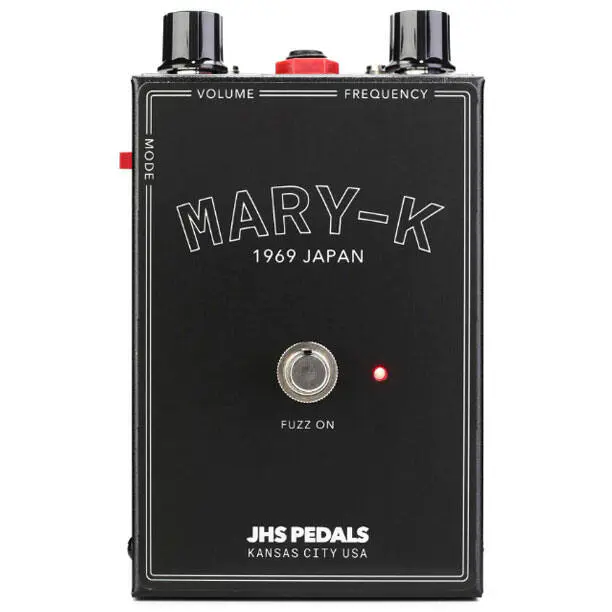
The JHS Mary-K Fuzz is a replica of an under-the-radar Japan-made fuzz circuit of the ’60s known as Key Fuzz Tone. Its maker, Kay Musical Instruments, released a series of streamlined pedal effects in the late ’60s that didn’t have any knobs, but that allowed one parameter of the effect to be modified via foot through a treadle, just like a wah pedal. The Key Fuzz Tone belongs to that series.
The JHS Mary-K places a modernized version of that circuit in a regular stompbox, allowing a wider sonic palette than the original thanks to its two knobs (Volume and Frequency) and also a Mode switch that delivers a more aggressively fuzzy and mid-rangey version of the original.
An Expression out allows using this pedal just like the vintage one, adjusting the Frequency setting using your foot, which produces a shift in frequency that’s comparable to a more subtle version of what you get placing a wah pedal after the fuzz.
Check out the sound of this obscure pedal that has its biggest fans in U2’s The Edge and Daniel Lanois.
JHS Mary-K Fuzz, Builder’s Notes
1969 KAY FUZZ TONE REPLICA
Kay Musical Instruments was founded by Henry “Kay” Kuhrmeyer on July 1, 1931. Although Henry quickly shifted production focus to all types of stringed instruments (including basses, violas and guitars), they didn’t enter the guitar pedal market until the late 1960s with a series of knobless, treadle-based delightfully odd plastic pedals. Each of these four units (the Fuzz Tone F1, Tremolo T1, Wah Wah W1 and Bass Boost B1) were housed in knobless, treadle-based enclosures allowing one parameter of each effect to be adjusted by foot.
The Kay Fuzz Tone was most likely released in late 1968/early 1969. Initially designed as a low-cost-version of the Shin-ei/Univox Superfuzz, this fuzz is one of the Edge’s go-to pedals. Fifty-four years later, JHS is releasing our spin on the Kay Fuzz Tone: the Mary-K. We’ve even added knobs and an expression pedal output for those who want to use it as it was originally intended.
Rather than using a treadle chassis, we allow Mary-K users the option to control the Frequency knob with an expression pedal. We recommend the Nektar NX-P and Roland EV-5 expression pedals, but many other expression pedals should also work. Be advised: some expression pedals may introduce a hum/noise into the signal chain in high electromagnetic interference environments. Therefore, we recommend using plastic chassis expression pedals with short cables to avoid unwanted noise in a high EMI environment.






















